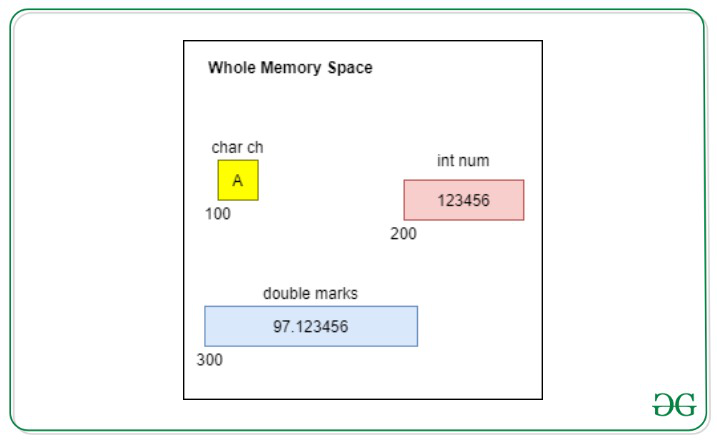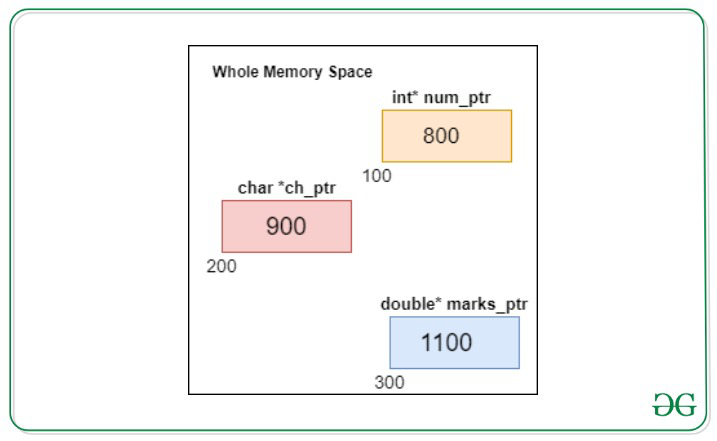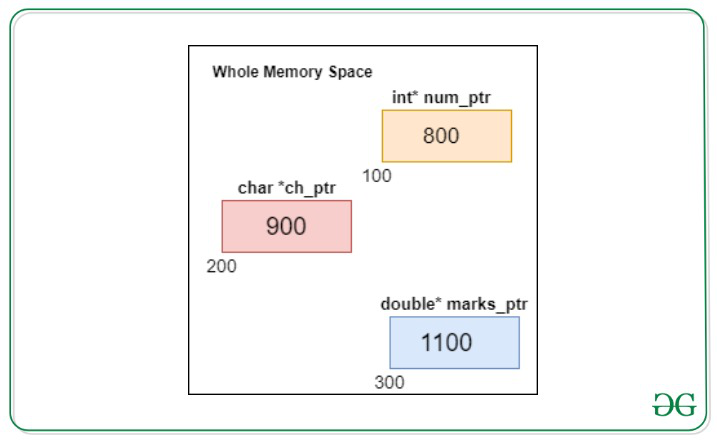本文概述
数据类型
简单来说, 数据类型为我们提供了有关数据类型的信息。
例如, 整数, 字符等。
C语言中的数据类型是
变量
。数据类型分类为:
原始或内置数据类型
原始数据类型的一些示例如下

变量名为ch表示内存地址100, 已占用1个字节的内存, 其中包含char数据类型” A”的值。
数是整数类型, 表示内存地址200, 已占用4个字节的内存, 并保留值123456。
分数是双精度类型的, 表示内存位置300, 已占用8个字节的内存, 并保留值97.123456。
注意:这些地址(100、200和300)仅用于理解目的, 实际地址为大十六进制数。
数组
数组是一个变量, 可以存储相同数据类型的多个值。数组是一个连续的内存段。
例子:
如果要存储100个整数, 则可以使用一个数组而不是使用100个不同的整数变量。
数组声明的语法:
data_type array_name[array_size];分配的空间量= sizeof(data_type)* array_size
例子:
声明一个可以容纳4个整数值的数组
int arr[4];
在这种情况下, sizeof(int)=4。因此, 4 * 4 =16内存字节保留给数组。
数组声明和初始化示例:
int arr[5] = {10, 20, 30, 40, 50};可以使用索引来访问数组元素, 索引的范围是0到(array_size-1)。
下面是在C中使用数组的示例代码:
C
//C implementation to demonstrate
//the usage of arrays
#include <stdio.h>
int main()
{
//Array Indexs-0 1 2 3 4
int arr[5] = { 10, 20, 30, 40, 50 };
int size = sizeof (arr);
printf ( "Size of array is %d\n" , size);
printf ( "Data at index 2 is %d\n" , arr[2]);
}输出如下
Size of array is 20
Data at index 2 is 30结构体
我们使用原始数据类型来存储数据。但是, 如果我们要存储的数据更复杂怎么办?
让我们考虑一个示例, 我们希望将一个班级中学生的信息存储在一个变量中。因此, 一个学生有:
- 卷号
- 名称
在此, 卷号是整数类型, 名称是字符串(字符数组)类型。
这里是解决方案:结构
- 结构是以单个名称表示的变量(可以是不同的数据类型)的集合。
- 它也是类似于数组的连续内存段, 但是它允许不同数据类型的数据成员。
定义结构的语法:
struct structure_name
{
datatype member1_name;
datatype member2_name;
..
datatype membern_name;
};例子:
struct student
{
int roll_number;
char name[20];
};现在我们有了新定义的数据类型, 结构学生。我们可以创建它的变量。
变量声明的语法:
struct structure_name variable_name;例子:
struct student ram;
//Members of structures can
//be accessed using "." operator
stu.roll_number = 64;
stu.name = "Saurabh";
当我们定义一个结构时, 没有分配内存。
结构的大小等于每个数据成员消耗的空间总量。
例子:
如果是学生结构, 则为4 + 20 = 24字节
下面是在代码帮助下的结构示意图:
C
//C implementation to demonstrate
//the usage of structures
#include <stdio.h>
#include <string.h>
//Structure Defination
struct student {
//data members
int roll_no; //4 bytes
char name[20]; //20 bytes
};
int main()
{
//Stucture variable Declaration
struct student stu;
stu.roll_no = 64;
strcpy (stu.name, "Saurabh" );
printf ( "Structure Data\n" );
printf ( "Roll No: %d\n" , stu.roll_no);
printf ( "Name: %s\n" , stu.name);
int size = sizeof (stu);
printf ( "Size of Structure student" );
printf ( "is %d" , size);
}输出如下
Structure Data
Roll No: 64
Name: Saurabh
Size of Structure studentis 24指针
- 指针是存储地址而不是变量值的特殊类型的变量。
- 它们用于间接访问变量。
- 如果var是变量的名称, 则&var给出的地址变种.
记住scanf函数中使用的&符号
scanf("%d", &var);这是因为我们将扫描的值分配给的存储位置变种.
我们对地址不感兴趣, 但是对存储在该地址的值不感兴趣。
指针声明的语法:
data_type* pointer_name; //(* = asterisk) 例子:
int* ptr;指针可以指向任何数据类型
它可以保存它指向的数据类型的任何变量的地址。
未初始化的指针变量的值为NULL。
例子:
int* ptr;
int num = 5;
ptr = #
为了获得指针所指向的地址的值, 我们使用asterisk(*)运算符。
因此, 在上面的示例中, ptr保持地址250, 并且该地址的值为5。
因此, * ptr等于5。
下面是在代码帮助下的指针说明:
C
//C implementation to demonstrate
//pointers in C
#include <stdio.h>
int main()
{
int * ptr;
int num = 5;
ptr = #
//This gives address of num
printf ( "Value at ptr is %p\n" , ptr);
//This gives value at num
printf ( "Value at *ptr is %d\n" , *ptr);
}输出如下
Value at ptr is 0x7ffdff4dca9c
Value at *ptr is 5指针变量的大小在系统中始终是恒定的, 而不管其指向的数据类型是什么, 通常为8个字节。

指向结构的指针
- 指向结构的指针可以声明为普通变量。
例子:
struct student *p;这里, p是指针和*p是结构
因此, 要访问数据成员, 我们必须使用
(*p).roll_no
(*p).nameC提供了一个特殊的运算符, 用于通过指针访问数据成员, 即->箭头运算符。
注意:(* p).x等效于p-> x
下面是该结构的指针的图示:
C
//C implementation to illustrate
//the code of the structures
#include <stdio.h>
#include <stdlib.h>
//Structure Defination
struct student {
int roll_no;
char name[20];
};
int main()
{
struct student* p;
p = ( struct student*)
malloc ( sizeof ( struct student));
//Arrow operator
p->roll_no = 99;
printf ( "The value at roll" );
printf ( "number is %d" , p->roll_no);
return 0;
}输出如下
The value at rollnumber is 99函数
- 函数是执行特定任务的代码块。
- 一个函数可以有一个输入, 执行任务, 然后提供一些输出。

在上面的示例中, 我们将输入作为2个数字提供给一个函数。正在执行加法功能。然后, 返回两个输入数字的总和。
- 输入被称为函数的参数
- 输出称为返回值
函数可以分为两类:
内置或预定义功能
这些在C语言的标准库中定义。我们不必定义这些函数, 只需调用这些函数即可。我们只需要知道正确的语法即可轻松使用这些功能。
例子:
printf(), scanf(), main()等是预定义的函数。
用户定义的功能
- 这些是程序员定义的用于执行程序中某些任务的功能。
- 将复杂的问题分成较小的块可以使我们的程序易于理解。
要使用用户定义的功能, 我们必须执行两个步骤
- 定义功能
- 通话功能
函数定义的语法:
return_type function_name(<parameters_list>)
{
--tasks/operations--
return return_value;
}注意:
- 一个函数可以具有0个或多个参数。
- 一个函数可以有0或1个返回值。
- 不返回任何内容的函数具有返回类型虚空
下面是C语言中函数的图示:
C
//C implementation to
//illustrate functions in C
#include <stdio.h>
//program to demonstrate functions
//function defination
//function to print something
void print()
{
printf ( "srcmini\n" );
}
//Function to add two numbers
int add( int a, int b)
{
int sum;
sum = a + b;
return sum;
}
//Main Function
int main()
{
int res;
//Function call
print();
res = add(5, 7);
printf ( "Sum is %d" , res);
}输出如下
srcmini
Sum is 12注意:在函数调用中传递的类型应该与函数体作为参数接收的类型兼容。否则, 将导致编译错误。
基于调用类型的功能分类:
通过值传递函数
- 当我们通过传递值来调用函数时(如上述程序), 原始变量的值不受影响。
- 而不是发送原始变量, 而是发送变量的副本。
下面是通过在C中传递值的函数调用的示意图:
C
//C implementation for the
//function call by passing value
#include <stdio.h>
//Function pass by value
void increase_by_one( int x)
{
x++;
}
int main()
{
int num = 5;
printf ( "Value before function" );
printf ( " call %d\n" , num);
increase_by_one(num);
printf ( "Value after function" );
printf ( " call %d\n" , num);
}输出如下
Value before function call 5
Value after function call 5在此程序中, 我们将变量a传递给函数, 该变量的值保持为5。然后, 将函数x接收到的变量的值增加了1。因此, x的值现在为6。但是, 此更改受到限制仅作用范围。 in main的值仍为5。
通过地址传递函数
- 如果要更改传递的变量的值, 则必须按地址传递变量。
- 此方法使用相同的变量, 而不是创建其新副本。
下面是通过地址传递函数的代码:
C
//C implementation to demonstrate
//the usage of function call by
//passing reference
#include <stdio.h>
//function to demonstarte
//call by value
void increase_by_one( int * x)
{
(*x)++;
}
int main()
{
int num = 5;
printf ( "Value before function" );
printf ( " call %d\n" , num);
increase_by_one(&num);
printf ( "Value after function" );
printf ( " call %d\n" , num);
}输出如下
Value before function call 5
Value after function call 6当我们传递变量的地址时, 我们必须将其作为指针变量接收。
功能:将数组作为参数传递
C
//C implementation to demonstrate
//the example of the passing as
//parameter in the function
#include <stdio.h>
//Function to print the array
void print_array( int arr[], int n)
{
//N is size of array
int i;
for (i = 0; i <n; i++)
printf ( "%d " , arr[i]);
}
int main()
{
int arr[5] = { 10, 20, 30, 40, 50 };
//Function Call
print_array(arr, 5);
}输出如下
10 20 30 40 50类型转换
类型转换基本上是将一种数据类型转换为另一种数据类型。
类型转换的语法:
var2 = (datatype2) var1
where, var1 is of datatype1 & var2 is of datatype2例子:
如果要将整数变量的值转换为float变量。
float x = (float)7/5;要了解有关类型转换的更多信息, 请参阅C中的类型转换
动态内存分配
如你所知, 数组是固定数量的值的集合。声明数组的大小后, 你将无法更改它。
有时, 你声明的数组大小可能不足。要解决此问题, 可以在运行时动态分配内存。这称为动态内存分配。
动态内存分配中使用的预定义函数:
1. malloc()
- malloc代表内存分配。
- malloc()函数保留指定数量的字节和void *的内存块, 可以将其转换为任何形式的指针。
malloc()的语法:
pointer_name = (cast_datatype*)malloc(size);2. free()
- 使用malloc()动态分配的内存不会自动释放。你必须显式使用free()释放此空间。
免费语法:
free(pointer_name);注意:这些函数在头文件stdlib.h中声明。要使用这些功能, 必须首先包含此标头。

下面是C语言中动态内存分配的说明:
C
//C implementation to demonstrate
//the code the Dynamic Memory
//Allocation
#include <stdio.h>
#include <stdlib.h>
int main()
{
int * ptr;
int n = 5, i;
ptr = ( int *) malloc (n * sizeof ( int ));
for (i = 0; i <n; i++)
ptr[i] = i;
printf ( "\nArray Elements are\n" );
for (i = 0; i <n; i++)
printf ( "%d " , ptr[i]);
free (ptr);
}输出如下
Array Elements are
0 1 2 3 4要了解有关动态内存分配的更多信息, 请参阅C中的动态内存分配
 srcmini
srcmini
评论前必须登录!
注册